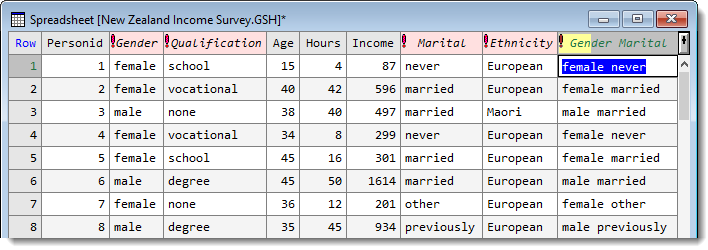You can combine two or more factors together to create a new factor. The new factor can include levels which represent all the combinations of combined factors or only those present in the data. This may be useful, for example, if a design is generated by regarding a set of the treatments as though they were the factorial combinations of a list of factors in order to confound some of the contrasts, say, with blocks. It may then be very much easier to set up the levels of the factors in the list rather than those of the full treatment factor (which can then be formed using this procedure).
The factor product produces a level for each factorial combination of the other factors that occurs. The levels are constructed by nesting the factor levels before combining them. For example with three factors F1, F2 and F3 with labels (A,B,C), (x,y) and (1,2) respectively, then the factor labels or the factor product of F1, F2 and F3 would be (Ax1, Ax2, Ay1, Ay2, Bx1, Bx2, By1, By2, Cx1, Cy2, Cx1, Cx2).
If the combination of B with x never occurred in the data, then the new levels will only contain the Bx1 and Bx2 items if the All combinations option is selected for the factor labels. If the order of combining the factors was changed to F3, F2 and F1 the new labels would be (1xA, 1xB, 1xC, 1yA, 1yB, 1xC, 2xA, 2xB, 2xC, 2yA, 2yB, 2yC).
The combined factors will appear as a new column in the source spreadsheet.
- Select the spreadsheet columns you want to combine by holding down Ctrl while clicking the column headers.

- From the menu select Spread | Factor | Product/Combine.

- You can accept the default factor product name, formed from the factors you selected, or type a new one.
- Enter a label separator character or leave this field blank to use a space as a separator.
- Select an option for defining factor levels then click OK.
The new column will appear with a half-yellow background to indicate that this is a calculated column. You can now edit the factor levels if required, adding meaningful names to each level.

| Label separator character |
Defines a separator character that will be placed between the original labels of the various factors. The default character used is a space. If the first factor has labels A and B and the second had no labels then the new labels using the default separator will be ‘A 1’ ‘A 2’ ‘B 1’ ‘B 2’. If a comma is used as the separator this will produce ‘A,1’ ‘A,2’ ‘B,1’ ‘B,2’, and if no separator is used this will produce ‘A1’ ‘A2’ ‘B1’ ‘B2’. |
| Factor labels | Controls how to define the levels for the new factor.
|